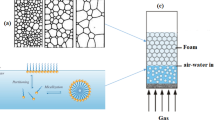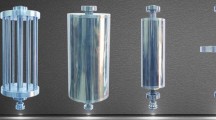Abstract
In the present study, we introduce a novel approach to control and modulate fluid transport inside microfluidic papers using lab-engineered paper sheets. Lab-sheets consisting of different fiber sources (eucalyptus sulfate and cotton linters pulp) and varying porosities were designed and further modified with small millimeter-scaled channels using hydrophobic barriers consisting of fiber-attached, hydrophobic polymers. The capillary-driven transport of an aqueous solution was monitored visually, and the influence of parameters such as fiber source, paper grammage, and channel width on the flow rates through the channel was investigated. The experimental results were compared with those obtained with commercially available filter papers. Our findings suggest that accurate control of fluid transport processes with standard filter papers is complex. Additionally, if the channel width is smaller than the mean fiber length, flow rates become dependent on the geometric parameters of the channel because of the formation of dead-end pores at the hydrophobic barriers. Finally, control of the paper sheets porosity, by varying the fiber density of the lab-made paper, affords the fabrication of chemically identical sheets whereby capillary flow is largely influenced and can be modulated accordingly by simple papermaking processes.






Similar content being viewed by others
References
Berchtold B (2005) Oberflächengebundene Polymernetzwerke zur Re-Endothelialisierung von porcinen Herzklappenbioprothesen. Dissertation, Albert-Ludwigs-Universität Freiburg im Breisgau
Böhm A, Gattermayer M, Trieb C, Schabel S, Fiedler D, Miletzky F, Biesalski M (2013a) Photo-attaching functional polymers onto cellulose fibers for the design of chemically modified paper. Cellulose 20(1):467–483
Böhm A, Gattermayer M, Carstens F, Schabel S, Biesalski M (2013b) Designing microfabricated paper devices through tailored polymer attachment. Adv Pulp Paper Sci Res, In: I’Anson SJ (ed) Trans. XVth fundamental res. symposium, Cambridge, FRC Cambridge, UK: 599–618
Brody JP, Yager P, Goldstein RE, Austin RH (1996) Biotechnology at low Reynolds numbers. Biophys J 71:3430–3441
Bruzewicz DA, Reches M, Whitesides GM (2008) Low-cost printing of poly(dimethylsiloxane) barriers to define microchannels in paper. Anal Chem 80:3387–3392
Carrilho E, Martinez AW, Whitesides GM (2009) Understanding wax printing: a simple micropatterning process for paper-based microfluidics. Anal Chem 81:7091–7095
Cheng CM, Martinez AW, Gong J, Mace CR, Phillips ST, Carrilho E, Mirica KA, Whitesides M (2010) Paper-based ELISA. Angew Chem Int Ed 49:4771–4774
Freidank D (2005) 3D-DNA-Chips: oberflächengebundene funktionelle Polymernetzwerke als Matrix für Nukleinsäure-Microarrays. Dissertation, Albert-Ludwigs-Universität Freiburg im Breisgau
Fu E, Ramsey SA, Kaufmann P, Lutz B, Yager P (2010a) Transport in two-dimensional paper networks. Microfluid Nanofluid 10:29–35
Fu E, Lutz B, Kaufmann B, Yager P (2010b) Controlled reagent transport in disposable 2D paper networks. Lab Chip 10:918–920
Hodgson K, Berg J (1988) The effect of surfactants on wicking flow in fiber networks. J Colloid Interface Sci 121:22–31
Kauffman P, Fu E, Lutz B, Yager P (2010) Visualization and measurement of flow in two-dimensional paper networks. Lab Chip 10:2614–2617
Klasner S, Price A, Hoeman K, Wilson R, Bell K, Culbertson C (2010) Paper-based microfluidic devices for analysis of clinically relevant analytes present in urine and saliva. Anal Bioanal Chem 397:1821–1829
Leung V, Shehata AAM, Filipe CDM, Pelton R (2010) Streaming potential sensing in paper-based microfluidic channels. Colloids Surf A 364:16–18
Li X, Tian J, Nguyen T, Shen W (2008) Paper-based microfluidic devices by plasma treatment. Anal Chem 80:9131–9134
Li X, Tian J, Shen W (2010) Progress in patterned paper sizing for fabrication of paper-based microfluidic sensors. Cellulose 17:649–659
Li X, Ballerini DR, Shen W (2012) A perspective on paper-based microfluidics: current status and future trends. Biomicrofluidics 6:011301
Liana DD, Raguse B, Gooding JJ, Chow E (2012) Recent advances in paper-based sensors. Sensors 12:11505–11526
Lu Y, Shi W, Jiang L, Qin J, Lin B (2009) Rapid prototyping of paper-based microfluidics with wax for low-cost, portable bioassay. Electrophoresis 30:1497–1500
Lucas R (1918) Über das Zeitgesetz des Kapillaren Aufstiegs von Flüssigkeiten. Colloid Polym Sci 23:15–22
Martinez AW, Phillips ST, Butte MJ, Whitesides GM (2007) Patterned paper as a platform for inexpensive, low-volume, portable bioassays. Angew Chem Int Ed 46:1318–1320
Martinez AW, Phillips ST, Whitesides GM (2008) Three-dimensional microfluidic devices fabricated in layered paper and tape. Proc Natl Acad Sci USA 105:19606–19611
Martinez AW, Phillips ST, Whitesides GM (2010) Diagnostics for the developing world: microfluidic paper-based analytical devices. Anal Chem 82:3–10
Noh H, Phillips ST (2010a) Metering the capillary-driven flow of fluids in paper-based microfluidic devices. Anal Chem 82:4181–4187
Noh H, Phillips ST (2010b) Fluidic “timers” for paper-based microfluidic devices. Anal Chem 82:8071–8078
Osborn JL, Lutz B, Fu E, Kauffmann P, Stevens DY, Yager P (2010) Microfluidics without pumps: reinventing the T-sensor and H-filter. Lab Chip 10:2659–2665
Phillips ST, Lewis GG (2013) Advances in materials that enable quantitative point-of-care assays. MRS Bull 38:315–319
Prucell EM (1977) Life at low Reynolds-numbers. Am J Phys 45:3–11
Songjaroen T, Dungchai W, Chailapakul O, Henry CS, Laiwattanapaisal W (2012) Blood seperation on microfluidic paper-based analytical devices. Lab Chip 12:3392–3398
Washburn EW (1921) The dynamics of capillary flow. Phys Rev 17:273–283
Acknowledgments
We thank Martina Ewald and Heike Herbert for various technical support. A. Böhm likes to thank the Excellency cluster “Center of Smart Interfaces, CSI” for a research scholarship. Financial support by the Hessian excellence initiative LOEWE within the cluster SOFT CONTROL and from the Verband der Papierfabriken (VDP), Grant No. INFOR 137, is gratefully acknowledged.
Author information
Authors and Affiliations
Corresponding author
Electronic supplementary material
Below is the link to the electronic supplementary material.
Rights and permissions
About this article
Cite this article
Böhm, A., Carstens, F., Trieb, C. et al. Engineering microfluidic papers: effect of fiber source and paper sheet properties on capillary-driven fluid flow. Microfluid Nanofluid 16, 789–799 (2014). https://doi.org/10.1007/s10404-013-1324-4
Received:
Accepted:
Published:
Issue Date:
DOI: https://doi.org/10.1007/s10404-013-1324-4




